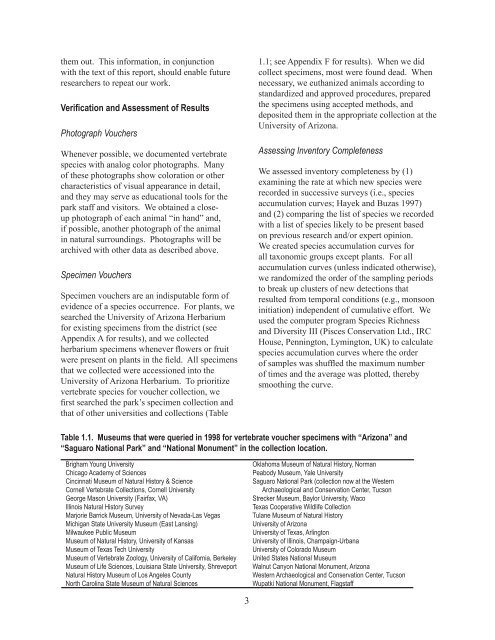Vascular Plant and Vertebrate Inventory of Saguaro ... - USGS
Vascular Plant and Vertebrate Inventory of Saguaro ... - USGS
Vascular Plant and Vertebrate Inventory of Saguaro ... - USGS
You also want an ePaper? Increase the reach of your titles
YUMPU automatically turns print PDFs into web optimized ePapers that Google loves.
them out. This information, in conjunction<br />
with the text <strong>of</strong> this report, should enable future<br />
researchers to repeat our work.<br />
Verification <strong>and</strong> Assessment <strong>of</strong> Results<br />
Photograph Vouchers<br />
Whenever possible, we documented vertebrate<br />
species with analog color photographs. Many<br />
<strong>of</strong> these photographs show coloration or other<br />
characteristics <strong>of</strong> visual appearance in detail,<br />
<strong>and</strong> they may serve as educational tools for the<br />
park staff <strong>and</strong> visitors. We obtained a closeup<br />
photograph <strong>of</strong> each animal “in h<strong>and</strong>” <strong>and</strong>,<br />
if possible, another photograph <strong>of</strong> the animal<br />
in natural surroundings. Photographs will be<br />
archived with other data as described above.<br />
Specimen Vouchers<br />
Specimen vouchers are an indisputable form <strong>of</strong><br />
evidence <strong>of</strong> a species occurrence. For plants, we<br />
searched the University <strong>of</strong> Arizona Herbarium<br />
for existing specimens from the district (see<br />
Appendix A for results), <strong>and</strong> we collected<br />
herbarium specimens whenever flowers or fruit<br />
were present on plants in the field. All specimens<br />
that we collected were accessioned into the<br />
University <strong>of</strong> Arizona Herbarium. To prioritize<br />
vertebrate species for voucher collection, we<br />
first searched the park’s specimen collection <strong>and</strong><br />
that <strong>of</strong> other universities <strong>and</strong> collections (Table<br />
3<br />
1.1; see Appendix F for results). When we did<br />
collect specimens, most were found dead. When<br />
necessary, we euthanized animals according to<br />
st<strong>and</strong>ardized <strong>and</strong> approved procedures, prepared<br />
the specimens using accepted methods, <strong>and</strong><br />
deposited them in the appropriate collection at the<br />
University <strong>of</strong> Arizona.<br />
Assessing <strong>Inventory</strong> Completeness<br />
We assessed inventory completeness by (1)<br />
examining the rate at which new species were<br />
recorded in successive surveys (i.e., species<br />
accumulation curves; Hayek <strong>and</strong> Buzas 1997)<br />
<strong>and</strong> (2) comparing the list <strong>of</strong> species we recorded<br />
with a list <strong>of</strong> species likely to be present based<br />
on previous research <strong>and</strong>/or expert opinion.<br />
We created species accumulation curves for<br />
all taxonomic groups except plants. For all<br />
accumulation curves (unless indicated otherwise),<br />
we r<strong>and</strong>omized the order <strong>of</strong> the sampling periods<br />
to break up clusters <strong>of</strong> new detections that<br />
resulted from temporal conditions (e.g., monsoon<br />
initiation) independent <strong>of</strong> cumulative effort. We<br />
used the computer program Species Richness<br />
<strong>and</strong> Diversity III (Pisces Conservation Ltd., IRC<br />
House, Pennington, Lymington, UK) to calculate<br />
species accumulation curves where the order<br />
<strong>of</strong> samples was shuffled the maximum number<br />
<strong>of</strong> times <strong>and</strong> the average was plotted, thereby<br />
smoothing the curve.<br />
Table 1.1. Museums that were queried in 1998 for vertebrate voucher specimens with “Arizona” <strong>and</strong><br />
“<strong>Saguaro</strong> National Park” <strong>and</strong> “National Monument” in the collection location.<br />
Brigham Young University Oklahoma Museum <strong>of</strong> Natural History, Norman<br />
Chicago Academy <strong>of</strong> Sciences Peabody Museum, Yale University<br />
Cincinnati Museum <strong>of</strong> Natural History & Science <strong>Saguaro</strong> National Park (collection now at the Western<br />
Cornell <strong>Vertebrate</strong> Collections, Cornell University Archaeological <strong>and</strong> Conservation Center, Tucson<br />
George Mason University (Fairfax, VA) Strecker Museum, Baylor University, Waco<br />
Illinois Natural History Survey Texas Cooperative Wildlife Collection<br />
Marjorie Barrick Museum, University <strong>of</strong> Nevada-Las Vegas Tulane Museum <strong>of</strong> Natural History<br />
Michigan State University Museum (East Lansing) University <strong>of</strong> Arizona<br />
Milwaukee Public Museum University <strong>of</strong> Texas, Arlington<br />
Museum <strong>of</strong> Natural History, University <strong>of</strong> Kansas University <strong>of</strong> Illinois, Champaign-Urbana<br />
Museum <strong>of</strong> Texas Tech University University <strong>of</strong> Colorado Museum<br />
Museum <strong>of</strong> <strong>Vertebrate</strong> Zoology, University <strong>of</strong> California, Berkeley United States National Museum<br />
Museum <strong>of</strong> Life Sciences, Louisiana State University, Shreveport Walnut Canyon National Monument, Arizona<br />
Natural History Museum <strong>of</strong> Los Angeles County Western Archaeological <strong>and</strong> Conservation Center, Tucson<br />
North Carolina State Museum <strong>of</strong> Natural Sciences Wupatki National Monument, Flagstaff

















